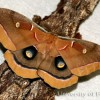Abstract
The polyphemus moth, Antheraea polyphemus (Cramer), is one of our largest and most beautiful silk moths. It is named after Polyphemus, the giant cyclops from Greek mythology who had a single large, round eye in the middle of his forehead. The name is because of the large eyespots in the middle of the moth’s hind wings. This 9-page fact sheet was written by Donald W. Hall and published by the UF Department of Entomology and Nematology, August 2012.
References
Arnaud PH. 1978. A Host-Parasite Catalog of North American Tachinidae (Diptera). United States Department of Agriculture Miscellaneous Publication 1319. Washington, D.C.
Brown SG, Boettner GH, Yack JE. 2007. Clicking caterpillars: acoustic aposematism in and other Bombycoidea. The Journal of Experimental Biology 210: 993-1005. https://doi.org/10.1242/jeb.001990
Collins MM, Weast RD. 1961.Wild Silk Moths of the United States: Saturniinae. Collins Radio Company. Cedar Rapids, Iowa. 138 pp.
Covell CV. 2005. A Field Guide to Moths of Eastern North America. Special Publication Number 12. Virginia Museum of Natural History. Martinsville, Virginia. 496 pp.
Cryan JP. 1973. Protective coloration used for defense by a polyphemus moth, Cramer, in flight. Engelhardtia 6(1): 14.
Ferguson DC. 1972. In Dominick RB, Edwards CR, Ferguson DC, Franclemont JG, Hodges RW, Munroe EG. The Moths of America North of Mexico, fasc. 20.2B, Bombycoidea (in part). EW Classey, LTD. Middlesex, England.
Godfrey GL, Jeffords M, Appleby JE. 1987. Saturniidae (Bombycoidea). In Stehr FW. Immature Insects. Kendall/Hunt Publishing Company. Dubuque, Iowa. pp. 513-521.
Heppner JB. 2003. Lepidoptera of Florida. Part 1. Introduction and Catalog. Volume 17 of Arthropods of Florida and Neighboring Land Areas. Division of Plant Industry. Florida Department of Agriculture and Consumer Services. Gainesville, Florida. 670 pp.
Hilton HO. 1965. Pupal escape mechanism of certain saturniid moths. Florida Entomologist 48: 239-24. https://doi.org/10.2307/3493776
Himmelman J. 2002. Discovering Moths: Nighttime Jewels in Your Own Backyard. Down East Books. Camden, Maine. 232 pp.
Holland WJ. 1968.The Moth Book: A Guide to the Moths of North America. Dover Publications, Inc. New York. (First published in 1903 by Doubleday, Page and Company. New York) 479 pp.
Hruska JF, Felsted RL, Law JH. 1973. Cocoonases of silkworm moths: catalytic properties and biological function. Insect Biochemistry 3: 31-43. https://doi.org/10.1016/0020-1790(73)90016-4
Hruska JF, Felsted RL, Law JH, Berger E, Kafatos FC. 1973. Cocoonase. IV. Mechanism of activation of prococoonase from words Antheraea polyphemus. The Journal of Biological Chemistry 248(9): 3012-3020. https://doi.org/10.1016/S0021-9258(19)44002-7
Kafatos FC, Williams CM. 1964. Enzymatic mechanism for the escape of certain moths from their cocoons. Science 146: 538-540. https://doi.org/10.1126/science.146.3643.538
Kochansky J, Tette J, Taschenberg EF, Carde RT, Kaissling K-E, Roelofs WL. 1975. Sex pheromone of the moth, Antheraea polyphemus. Journal of Insect Physiology 21: 1977-1983. https://doi.org/10.1016/0022-1910(75)90230-9
Kochansky J, Carde RT, Taschenberg EF, Roelofs WL. 1977. Rhythms of male attraction and female attractiveness, and an improved pheromone synthesis. Journal of Chemical Ecology 3(4): 419-427. https://doi.org/10.1007/BF00988185
Krombein KV, Hurd PD, Jr, Smith DR, Burks BD. 1979. Catalog of Hymenoptera in America North of Mexico. Vol. 1, Symphyta and Apocrita (Parasitica). Smithsonian Institution Press, Washington, D.C. 2735 pp.
Mansingh A, Smallman BN. 1967. Effect of photoperiod on the incidence and physiology of diapause in two saturniids. Journal of Insect Physiology 13: 1147-1162. https://doi.org/10.1016/0022-1910(67)90089-3
Mansingh A, Smallman BN. 1971. The influence of temperature on the photoperiodic regulation of diapause in saturniids. Journal of Insect Physiology 17: 1735-1739. https://doi.org/10.1016/0022-1910(71)90070-9
Miller TA, Machotka SV. 1980. Sex-related morphological characters in larvae of Hyalophora gloveri gloveri and Antheraea polyphemus (Saturniidae). Journal of the Lepidopterists' Society 34(1): 69-73.
O'hara JE, Wood DM. 2004. Catalogue of the Tachinidae (Diptera) of North America north of Mexico. Associated Publishers. Gainesville, Florida 410 pp.
Opler, PA, Lotts K, Naberhaus T, coordinators. 2012. Butterflies and Moths of North America.
Packard AS. 1914. Monograph of the Bombycine Moths of North America. Part 3. Memoirs of the National Academy of Science 12: 1-516.
Peck O. 1963. A catalogue of the Nearctic Chalcidoidea (Insecta: Hymenoptera). Canadian Entomologist. Supplement 30. Canada Department of Agriculture. Ottawa, Canada. 1092 pp. https://doi.org/10.4039/entm9530fv
Peterson A. 1965. Some eggs of moths among the Sphingidae, Saturniidae, and Citheroniidae (Lepidoptera). Florida Entomologist 48: 213-219. https://doi.org/10.2307/3493773
Powell JA. 2003. Lepidoptera (Moths, Butterflies). Resh VH, Carde RT, editors. Encyclopedia of Insects. Elsevier Science (USA) San Diego, California. pp. 631-663.
Tietz HM. 1972. An Index to the Described Life Histories, Early Stages and Hosts of the Macrolepidoptera of the Continental United States and Canada. Part 1. The Allyn Museum of Entomology. Sarasota, Florida. (Distributed by Entomological Reprint Specialists. Los Angeles, California). 536 pp.
Townes HK. 1944. A Catalog and Reclassification of the Nearctic Ichneumonidae (Hymenoptera). Part 1. Memoirs of the American Entomological Society. American Entomological Society. Philadelphia, Pennsylvania. Volume 11: 1-477.
Tuskes PM, Tuttle JP, Collins MM. 1996. The Wild Silk Moths of North America: The Natural History of the Saturniidae of the United States and Canada. Cornell University Press. Ithaca, New York. 250 pp. https://doi.org/10.7591/9781501738005
Villiard P. 1975. Moths and How to Rear Them. Dover Publications, Inc. New York, New York. 242 pp.
Wagner DL. 2005. Caterpillars of Eastern North America. Princeton University Press. Princeton, New Jersey. 512 pp.
Wagner WH, Mayfield 1980. Foodplants and cocoon construction in Antheraea polyphemus (Lepidoptera: Saturniidae) in southern Michigan. The Great Lakes Entomologist 13(3): 131-138.
Waldbauer GP. 1996. Insects Through the Seasons. Harvard University Press. Cambridge, Massachusetts. 289 pp.
Waldbauer GP, Sternburg JG, George WG, Scarbrough AG. 1970. Hairy and downy woodpecker attacks on cocoons of urban Hyalophora cecropia and other saturniids (Lepidoptera). Annals of the Entomological Society of America 63(5): 1366-1369. https://doi.org/10.1093/aesa/63.5.1366
Worth CB. 1980. An elegant harness for tethering large moths. Journal of the Lepidopterists' Society 34(1): 61-63.
Worth CB, Muller J. 1979. Captures of large moths by an UV light trap. Journal of the Lepidopterists' Society 33: 261-264.
Young AM. 1982. Predation on the pupae of Saturniidae (Lepidoptera) by gray squirrels in Wisconsin. The Great Lakes Entomologist 15(2): 145.

